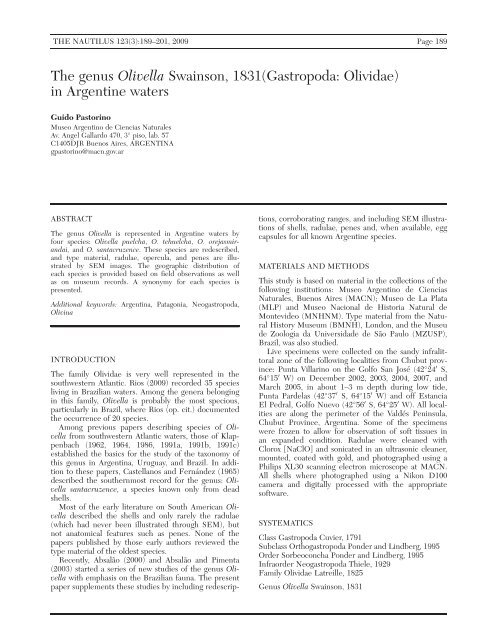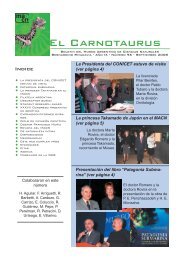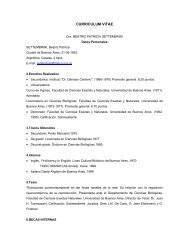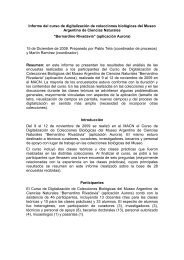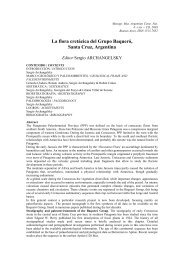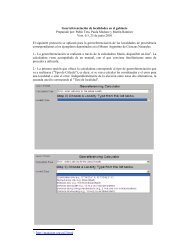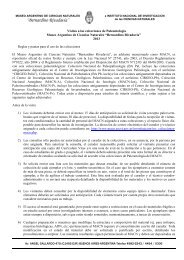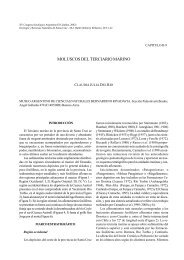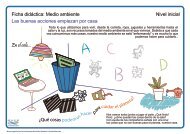The genus Olivella Swainson, 1831(Gastropoda: Olividae) - Museo ...
The genus Olivella Swainson, 1831(Gastropoda: Olividae) - Museo ...
The genus Olivella Swainson, 1831(Gastropoda: Olividae) - Museo ...
Create successful ePaper yourself
Turn your PDF publications into a flip-book with our unique Google optimized e-Paper software.
THE NAUTILUS 123(3):189–201, 2009 Page 189<strong>The</strong> <strong>genus</strong> <strong>Olivella</strong> <strong>Swainson</strong>, <strong>1831</strong>(<strong>Gastropoda</strong>: <strong>Olividae</strong>)in Argentine watersGuido Pastorino<strong>Museo</strong> Argentino de Ciencias NaturalesAv. Angel Gallardo 470, 3 piso, lab. 57C1405DJR Buenos Aires, ARGENTINAgpastorino@macn.gov.arABSTRACT<strong>The</strong> <strong>genus</strong> <strong>Olivella</strong> is represented in Argentine waters byfour species: <strong>Olivella</strong> puelcha, O. tehuelcha, O. orejasmirandai,and O. santacruzence. <strong>The</strong>se species are redescribed,and type material, radulae, opercula, and penes are illustratedby SEM images. <strong>The</strong> geographic distribution ofeach species is provided based on field observations as wellas on museum records. A synonymy for each species ispresented.Additional keywords: Argentina, Patagonia, Neogastropoda,OlivinaINTRODUCTION<strong>The</strong> family <strong>Olividae</strong> is very well represented in thesouthwestern Atlantic. Rios (2009) recorded 35 speciesliving in Brazilian waters. Among the genera belongingin this family, <strong>Olivella</strong> is probably the most specious,particularly in Brazil, where Rios (op. cit.) documentedthe occurrence of 20 species.Among previous papers describing species of <strong>Olivella</strong>from southwestern Atlantic waters, those of Klappenbach(1962, 1964, 1986, 1991a, 1991b, 1991c)established the basics for the study of the taxonomy ofthis <strong>genus</strong> in Argentina, Uruguay, and Brazil. In additionto these papers, Castellanos and Fernández (1965)described the southernmost record for the <strong>genus</strong>: <strong>Olivella</strong>santacruzence, a species known only from deadshells.Most of the early literature on South American <strong>Olivella</strong>described the shells and only rarely the radulae(which had never been illustrated through SEM), butnot anatomical features such as penes. None of thepapers published by those early authors reviewed thetype material of the oldest species.Recently, Absalão (2000) and Absalão and Pimenta(2003) started a series of new studies of the <strong>genus</strong> <strong>Olivella</strong>with emphasis on the Brazilian fauna. <strong>The</strong> presentpaper supplements these studies by including redescriptions,corroborating ranges, and including SEM illustrationsof shells, radulae, penes and, when available, eggcapsules for all known Argentine species.MATERIALS AND METHODSThis study is based on material in the collections of thefollowing institutions: <strong>Museo</strong> Argentino de CienciasNaturales, Buenos Aires (MACN); <strong>Museo</strong> de La Plata(MLP) and <strong>Museo</strong> Nacional de Historia Natural deMontevideo (MNHNM). Type material from the NaturalHistory Museum (BMNH), London, and the Museude Zoologia da Universidade de São Paulo (MZUSP),Brazil, was also studied.Live specimens were collected on the sandy infralittoralzone of the following localities from Chubut province:Punta Villarino on the Golfo San José (42 24 0 S,64 15 0 W) on December 2002, 2003, 2004, 2007, andMarch 2005, in about 1–3 m depth during low tide,Punta Pardelas (42 37 0 S, 64 15 0 W) and off EstanciaEl Pedral, Golfo Nuevo (42 56 0 S, 64 25 0 W). All localitiesare along the perimeter of the Valdés Peninsula,Chubut Province, Argentina. Some of the specimenswere frozen to allow for observation of soft tissues inan expanded condition. Radulae were cleaned withClorox [NaClO] and sonicated in an ultrasonic cleaner,mounted, coated with gold, and photographed using aPhilips XL30 scanning electron microscope at MACN.All shells where photographed using a Nikon D100camera and digitally processed with the appropriatesoftware.SYSTEMATICSClass <strong>Gastropoda</strong> Cuvier, 1791Subclass Orthogastropoda Ponder and Lindberg, 1995Order Sorbeoconcha Ponder and Lindberg, 1995Infraorder Neogastropoda Thiele, 1929Family <strong>Olividae</strong> Latreille, 1825Genus <strong>Olivella</strong> <strong>Swainson</strong>, <strong>1831</strong>
Page 190 THE NAUTILUS, Vol. 123, No. 3Figures 1–12. <strong>Olivella</strong> puelcha (Duclos, 1835). 1–3. Syntype of a female of Olivina tehuelchana d’Orbigny, BMNH1854.12.4.409, Bahía San Blas, Argentina. 4–7. Syntype (male) of Olivina tehuelchana d’Orbigny, BMNH 1854.12.4.409, Bahía SanBlas, Argentina. 8–10. MACN-In 16828-1, coast of Buenos Aires Province. 11. Syntype (male) of Olivina tehuelchana d’Orbigny,BMNH 1854.12.4.409. 12. External view of the operculum. Scale bars: All shells = 1 mm; Figure 12 = 400 mm.
G. Pastorino, 2009 Page 191Figures 13–19. <strong>Olivella</strong> puelcha (Duclos, 1835). 13. Apertural view of an embryonic shell. 14. Adapertural view of anotherembryonic shell. 15. Open egg capsule with an embryo inside. 16. Closed egg capsule. 17. Detail of the protoconch, scale bar =500 mm. 18. Shell ultrastructure, fracture surface commarginal. 19. Penis, critical-point dried. Scale bars: Figures 15, 16 = 500 mm;18 = 50 mm; 19 = 1000 mm.Type Species: Oliva dama Mawe, 1828 by subsequentdesignation (Dall, 1909).<strong>Olivella</strong> puelcha (Duclos, 1835)(Figures 1–19, 39–41)Oliva puelcha Duclos, 1835: pl. 4 bis, fig. 1–6, 20.Oliva tehuelchana d’Orbigny,1839:pl.59,fig.7–12;Marrat,1871: 38, fig. 457.Olivina tehuelchana d’Orbigny, 1840: 418.Oliva tehuelcha Duclos in Chenu, 1844: 6; Chenu, 1845: pl. 5,fig. 1–6.Olivancillaria auricularia plata Ihering, 1908: 432.<strong>Olivella</strong> tehuelchana (d’Orbigny, 1841).—Carcelles, 1944: 258;Castellanos and Fernández, 1965: 103, fig. 6–9; Castellanos,1970: 122 pl. 10, fig. 5.<strong>Olivella</strong> tehuelcha (Duclos, 1840).—Rios, 1985: 114,fig. 506; 1994: 144, fig. 630; 2009, fig. 687 (description is O.puelcha).<strong>Olivella</strong> puelcha (Duclos, 1835).—Klappenbach, 1991b: 121.<strong>Olivella</strong> plata Ihering, 1909 [sic].—Castellanos andFernández, 1965: 101, fig. 4–5, 12, 13; Castellanos, 1970:123; Rios, 1985: 113, fig. 504; 1994: 145, fig. 628; Borzone,1995: 52, figs. 28, 29; Rios, 2009: 275.<strong>Olivella</strong> plata (Ihering, 1908).—Pastorino, 1995: 10, Pl. 2, fig.12; Pastorino, 2007: 1, Fig. 1, A–J.
Page 192 THE NAUTILUS, Vol. 123, No. 3Description: Shell of small size for <strong>genus</strong>, (to 11 mm),subquadrate, of 5 completely smooth, flat whorls.Protoconch of about 1.5–2 smooth whorls (Figure 17).Transition to teleoconch indistinct. Spire of medium size,suture channeled, narrowly open. Parietal callus smooth,broad, thick; Columella with one plait weakly divided inmiddle, becoming two plaits toward aperture. Fasciolarband moderately wide, posterior groove weak. Sexualdimorphism evident in shells of this species: Shells offemales have wide vertical anterior groove, adjacent toparietal callus and columellar pillar structure. <strong>The</strong>groove curves adaxially at tip of also adaxially curvedpillar, is absent in shells of males where parietal callus,apparently “fills in” groove described for female shells.Color always bright-white. Shell ultrastructure composedof thick outer layer of crossed-lamellar crystalsand an extremely thin inner layer of apparently amorphousconstitution. Radula rachiglossate, rachidian teethwide, slightly concave, with convex, somewhat ellipticalbase. Cusp flat, rectangular, with rounded tips near centerof tooth, becoming smaller, more broadly spaced, andsharper toward sides of tooth. Lateral teeth, flat, smooth,curved, blunted at ends, with thin, polygonal attachmentarea at base. Operculum semicircular, filling the wholeaperture; nucleus subterminal, somewhat lateral. Growthlines, closely spaced over entire surface (Figure 12). Penisvery long, thin, tapering, with curved tip at distal end(Figure 19). Egg capsules semicircular, each containing asingle embryo (Figures 13–16).Type Material: Thirteen syntypes of Olivina tehuelchanad’Orbigny, BMNH 1854.12.4.409, two femalesand 11 males. <strong>The</strong> type material of Olivancillaria auriculariaplata Ihering was not localized, apparently it wasnever deposited.Type Locality: “Côtes sablonneuses des îles de la baieSan-Blas”, sandy coasts of San Blas Bay Islands for O.tehuelchana; Punta Piedras, Buenos Aires Province, for<strong>Olivella</strong> plata Ihering.Other Material Examined: MACN-In 30306, 37 28 0S, 56 20 0 W; MACN-In 14348, 38 35 0 S, 57 09 0 W, in 102m; MACN-In 16289, (all will hermit crabs), 38 52 0 S,56 20 0 W in 90 m, Mar del Plata; MACN-In 16496-1;16496, both from Punta Médanos; MACN-In 6619-42;6619-41, Monte Hermoso, Buenos Aires province;MACN 16828-1, Buenos Aires province coast; MACN-In 30333, 16630, 30317, 30334, 20244, all from BahíaSan Blas, Buenos Aires province; MACN-In 37603,Punta Villarino, Golfo San José, 42 24 0 S, 64 15 0 W, 1–3m depth during low tide; MACN-In 37604, Punta Pardelas,42 37 0 S, 64 15 0 W, Golfo Nuevo, Chubut, 6 m depth.Geographic Distribution: Rio Grande do Sul, Brazil(Rios, 1994; 2009) to Puerto Pirámide, Golfo Nuevo,Chubut, Argentina.Remarks: In a short note on the <strong>genus</strong> <strong>Olivella</strong>, Klappenbach(1991b) reviewed the taxonomic history of thetwo South Atlantic species of <strong>Olivella</strong> described byd’Orbigny. A number of factors led subsequent authors toconfuse the true identity of these species and preventingcorrect placement of the material in the appropriate taxon.D’Orbigny collected his original material during his voyageto South America and, after returning to France, describedthem as Oliva tehuelchana and Oliva puelchana,publishing the plates in 1839 and the descriptions in 1840.However, before publication of either, he apparently senthis illustrations to Duclos. In 1835, Duclos publishedplates with illustrations of these two species in his monographof the <strong>genus</strong> Oliva, apparently reproduced from theillustrations that d’Orbigny sent to him. Duclos changedthe final part of the names (“puelcha”for“puelchana”and“tehuelcha” for“tehuelchana”) and also transposed thenames in the plates. In fact, as d’Orbigny stated in hispublication several years later (1840: 418, footnote), bothnames are transposed in Duclos’s monograph, so Duclos’sOliva puelcha and O. tehuelcha are d’Orbigny’s Olivinatehuelchana and O. puelchana, respectively. As Duclos’smonograph was published earlier, his names have priorityover d’Orbigny’s. Aguirre (1993: 30) was aware of Duclos’earlier names. However, she maintained d’Orbigny’snames although she considered them synonyms [as <strong>Olivella</strong>puelchana (d’Orbigny, 1840)]. Unfortunately, shedesignated (Aguirre, 1993: 30, pl. I, fig. 5) the lectotypefor Olivina puelchana d’Orbigny, 1840 [=<strong>Olivella</strong> tehuelchaDuclos], a specimen from lot BMNH 1854.12.4.409,which is actually one of the 13 syntypes of Olivina tehuelchanad’Orbigny, 1840 [= O. puelcha Duclos]. <strong>The</strong>refore,such lectotype designation is invalid under the provisionsof Article 74.2 of the International Code of ZoologicalNomenclature (ICZN, 1999). Aguirre illustrated the specimenshe selected as lectotype, which is clearly a malespecimen of O. puelcha (Duclos).<strong>Olivella</strong> plata was described originally as a subspeciesof Olivancillaria auricularia in a very short descriptiontogether with other Quaternary species (Ihering, 1908).Ihering mentioned <strong>Olivella</strong> tehuelchana two lines abovethat, although it is difficult to believe that he could notdifferentiate between the genera Olivancillaria and <strong>Olivella</strong>.Castellanos and Fernández (1965: 103) reportedseeing the type specimen. <strong>The</strong> only material they hadavailable was lot MACN-In 6619, which contained severalspecimens and included a handwritten label fromDoello-Jurado (former curator of the Invertebrate Divisionat the MACN), explaining that the material was splitfrom a larger lot (also housed at the MACN) and identifiedas “O. tehuelchana d’Orbigny” (=O. puelchaDuclos) by Ihering. <strong>The</strong>se facts apparently lead Castellanosand Fernández to the erroneous conclusion thatthis was the type material of O. plata. <strong>The</strong> locality datafor this lot was Monte Hermoso, while the type localityfor O. plata is Punta Piedras (Ihering, 1908: 432). Part ofIhering’s type material is housed at the MACN and partat the MZUSP. After a careful revision of both collectionsit is evident that the type material of O. plata wasnot deposited in either of these institutions and wasnever illustrated. Nevertheless, the characteristic shape
G. Pastorino, 2009 Page 193of the anterior part of the females of O. puelcha allowsthe identification with some confidence and the posteriorsynonymization of O. plata.Pastorino (2007) described the sexual dimorphism ofthis species (as O. plata). A careful study of the entiretype series of Olivina tehuelchana d’Orbigny [=<strong>Olivella</strong>puelcha Duclos] housed at the BMNH allows the recognitionof both sexual morphs, establishing that the maleswere described by Duclos and d’Orbigny as Oliva puelchaand Olivina tehuelchana, respectively and, severalFigures 20–27. <strong>Olivella</strong> tehuelcha (Duclos, 1835). 20–22. Syntype of Olivina puelchana d’Orbigny, BMNH 1854.12.4.408,Bahía San Blas, Argentina. 23–25. Another syntype of Olivina puelchana d’Orbigny, BMNH 1854.12.4.408, Bahía San Blas.26. MACN-In 37605, Punta Pardelas, Golfo Nuevo, Argentina. 27. Detail of the columella plaits of MACN-In 16675. Scalebar = 3 mm.
Page 194 THE NAUTILUS, Vol. 123, No. 3Figures 28–38. <strong>Olivella</strong> tehuelcha (Duclos, 1835). 28–29. Two views of MACN-In 37605, Punta Pardelas, Golfo Nuevo, Argentina,coated for SEM. 30–31. Detail of the parietal callus. 32. Ultrastructure, fracture surface commarginal. 33–34. Protoconch,33. apical view. 34. Lateral view. 35. Detail of columellar plaits of MACN-In 37605. 36–37. Penis, critical-point dried. 37. Detail ofthe papilla. 38. SEM, external view of the operculum. Scale bars: Figures 30, 31 = 100 mm; 32 = 180 mm; 33 = 200 mm; 34 = 300 mm;35 = 800 mm; 36 = 1000 mm; 37 = 500 mm; 38 = 1000 mm.
G. Pastorino, 2009 Page 195Figures 39–45. <strong>Olivella</strong> radulae. 39–41. <strong>Olivella</strong> puelcha (Duclos, 1835). 39. General view. 40. Detail of the rachidian teeth ofthe radula in Figure 39. 41. Detail of the cusps of the rachidian in Figure 40. 42–45. <strong>Olivella</strong> tehuelcha (Duclos, 1835). 42. Generalview, arrows head quadrangular piece underlying lateral teeth. 43. Detail of the rachidian teeth of the radula in Figure 42.44. Detail of the cusps of the rachidian in Figure 43. 45. Lateral view of the radula. Scale bars: Figure 39 = 50 mm; 40 = 20 mm;41 = 5 mm; 42 = 100 mm; 43 = 20 mm; 44 = 10 mm; 45 = 100 mm.
Page 196 THE NAUTILUS, Vol. 123, No. 3decades later, the females as Olivancillaria auriculariaplata by Ihering.Borzone (1995) briefly described the egg capsulesfrom material collected in southern Brazil (as O. plata).<strong>The</strong> embryos and egg capsules, illustrated here (Figures13–16), were collected during the southern hemispheresummer (November–January).<strong>Olivella</strong> tehuelcha (Duclos, 1835)(Figures 20–38, 42–45)Oliva tehuelcha Duclos, 1835: pl. 4 bis, fig. 7–14, 21.Oliva puelchana d’Orbigny, 1839: pl. 59, fig. 13–19; Marrat,1871: 35, figs. 461, 462.Olivina puelchana d’Orbigny, 1840: 418.Oliva puelchana Duclos in Chenu, 1844: 6.Oliva puelcha Duclos in Chenu, 1845: pl. 5, figs. 7–14.<strong>Olivella</strong> jaspidea Gmelin.—Dall, 1890: 310 (according toKlappenbach, 1991c).<strong>Olivella</strong> puelchana d’Orbigny.—Formica-Corsi, 1900: 80, fig. 19;Carcelles, 1944: 159; Castellanos and Fernández, 1965: 103,figs. 1–3; Castellanos, 1970: 122, pl. 10, fig. 6; Aguirre, 1993:30, pl. I, fig. 5.<strong>Olivella</strong> tehuelcha (Duclos, 1835).—Klappenbach, 1964: fig. 5;1991b: 121; Abbott and Dance, 1986: 194.<strong>Olivella</strong> puelcha (Duclos, 1840).—Rios, 1985: 114, fig. 505; Calvo,1987: 164, fig. 151; Rios, 1994: 144, fig. 630.Description: Shell medium size for the <strong>genus</strong>, up to15 mm in length, subovate, elliptic, solid, with fivesmooth, flat whorls. Protoconch with at least twowhorls, totally smooth; transition to teleoconch notclearly defined (Figures 33, 34). Color variable, withlight or dark brownish background, some specimenswith brighter, closely arranged, flamules. Spire elevated,
G. Pastorino, 2009 Page 197Figures 46–53. <strong>Olivella</strong> santacruzence Castellanos and Fernández, 1965. 46–52. MLP 3863 paratypes, Punta Medanosa, SantaCruz province, Argentina. 53. Detail of the columellar plaits of the shell in Figure 51. Scale bar, all shells = 3 mm.band wide, distinctly colored, posterior groove well defined.Soft parts unknown.Type Material: Six paratypes, MLP 3863 (incorrectlypublished by the authors as 27284). However, only fiveare referable to this species, as the sixth is a juvenilemale of O. puelcha. None of these specimens match thepublished size of the holotype, which is apparently lost.All the specimens are beach-collected.Type Locality: Punta Medanosa, Santa Cruz Province,Argentina (approximately 48 04 0 S, 65 56 0 W). Thislocality was recently visited, but specimens could not befound.Distribution:Known only from the type locality.<strong>Olivella</strong> orejasmirandai Klappenbach, 1986(Figures 54–59)<strong>Olivella</strong> (Olivina) orejasmirandai Klappenbach, 1986: 2, figs. 1–5;Rios, 1994: 145, pl. 47, fig. 627.Description: Shell small size for the <strong>genus</strong>, reaching8 mm in length, elongated, solid, with five smooth, very flatwhorls. Protoconch with 1.5 whorls, totally smooth; transitionto teleoconch visible. Color whitish, some specimenstranslucent, with a subsutural weak white line. Spire elevated,conical,
Page 198 THE NAUTILUS, Vol. 123, No. 3Figures 54–59. <strong>Olivella</strong> orejasmirandai Klappenbach, 1986. 54–56. Holotype, MNHNM 14765, 33 17 0 S, 50 34 0 W, Off Albardão,Rio Grande do Sul State, Brazil. 57. Paratype, MNHNM 14766, tilted 30 to show curved columella. 58. Holotype, radula.59. Detail of rachidian teeth of same radula. Scale bars: Figure 57 = 1 mm; 58 = 50 mm; 59 = 20 mm.straight, with sudden change of direction beyond columella.Outer lip sharp. Aperture triangular. Columella with onlyone plait. Fasciolar band white, posterior groove distinct,deep. Radula rachiglossate, with 22 rows of teeth. Rachidianteeth with strongly curved base; 38–40 denticles ofsame size along middle of rachidian, but getting thinnertoward sides. Lateral teeth typically curved, sharp atend. A quadrangular piece is present under lateral teeth.
G. Pastorino, 2009 Page 199Figures 60–70. <strong>Olivella</strong> cf. riosi Klappenbach, 1991. 60–62. MACN-In, 37602, 42 56 0 S, 64 25 0 W, 15 m depth, about 700 m offEstancia el Pedral Golfo Nuevo, Chubut, Argentina. 63–64. Holotype of O. riosi Klappenbach, 1991, MNHNM 14773, 35 36 0 05 00 S,53 32 0 00 00 W. 65–67. Another specimen, same locality as for Figures 60–62. 68. Operculum of the specimen in Figures 60–62.69. Radula, general view. 70. Radula, rachidian teeth. Scale bars: All shells = 1 mm; Figure 69 = 50 mm; 70 = 30 mm.
Page 200 THE NAUTILUS, Vol. 123, No. 3Operculum translucent, yellowish, elliptical. Unfortunately,no soft parts are known other than radula and operculum.Type Material: Holotype MNHNM 14765; paratypes,MNHNM 14766, 11017 and 14769.Type Locality: Off Albardão, Rio Grande do Sulstate, Brazil (33 17 0 S, 50 34 0 W) in 173 m. Paratypes:Off Rio de la Plata, Samborombón Bay.Distribution: Southern Brazil, off Cabo Santa María,Uruguay, and off Río de la Plata, Argentina.Remarks: This taxon is presently known only from thetype material. <strong>The</strong> radulae were re-studied and illustratedfrom the original slides. It is somewhat different from whatis depicted in the author’s illustrations. Figures 58 and 59show the denticles of the rachidian of almost the samesize in the middle of the teeth and larger than those fromthe tips.<strong>Olivella</strong> cf. riosi Klappenbach, 1991(Figures 60–70)<strong>Olivella</strong> (Olivina) riosi Klappenbach, 1991a: 2, figs. 1 3, [7 10in error in the original publication] 4, 5; 9 10.Description: Shell very small for the <strong>genus</strong>, up to 6.5mm, suboval, of 4–4.5 flat, smooth whorls; Protoconchshort, number of whorls hard to determine, as there is novisible transition to the teleoconch. Color pale reddish orbrownish with indistinct withish subsutural band. Spirevery low, suture canaliculated, wide. Parietal callus pronounced,smooth, well defined. Columella with one flat,wide plait. Fasciolar band wide, whitish; posterior grooveobsolete.Radula rachiglossate, with 18 rows of teeth. Rachidianteeth narrow, with small curved base; 34–36 sharp denticlesof irregular size along middle of each tooth, diminishingtoward sides. Lateral teeth, long, typically curved,with blunt ends and flat profile. Under laterals a quadrangularpiece is present. Operculum extremely thin,translucid, subterminal nucleus. Growth lines coveringentire surface.Distribution: Known only from about 700 m off Estanciael Pedral, Golfo Nuevo, Chubut, Argentina(42 56 0 S, 64 25 0 W) in 15 m depth.Remarks: <strong>The</strong>se two specimens were compared tothe type material of O. riosi. At present there is no clearway to separate the two species. However, as more materialbecomes available (male specimens), this mayprove to be a new species.DISCUSSIONFour species of <strong>Olivella</strong> are presently known to occur inArgentine waters. Of these, three are also recorded fromUruguay and Brazil. It is clear that the <strong>genus</strong> is basically atemperate group so the diversity decreases in colder waters.In his classical paper on the <strong>Olivella</strong> of North andCentral America, Olsson (1956) reviewed a large numberof species and established subgenera based primarily onshell and radular characters. He included the two commonspecies from Argentina, O. puelcha (as O. tehuelchana)and O. tehuelcha (as O. puelchana), as well as thenorthern O. bullula, in the sub<strong>genus</strong> Olivina d’Orbigny,for which O. puelcha Duclos (=O. tehuelchana d’Orbignyin the original) serves as type species. <strong>The</strong> main charactersestablished by Olsson for the sub<strong>genus</strong> Olivina are:narrow sutures, and a low columella, with one or twofolds. <strong>The</strong>se characteres are actually very variable, andsome included species (e.g., O. santacruzence, with severalcolumellar folds) do not conform to these criteria.<strong>The</strong> presence of the operculum was considered by Olssonto be a subgeneric character. However, neither themorphology of the radulae nor of the penes were used todistinguish the subgenera.My review of several of the South American species of<strong>Olivella</strong> shows that the morphology of the penis appearsto be a distinguishing feature for taxonomic decisions.Most of the species described here as well as some ofthe Brazilian species (e.g., <strong>Olivella</strong> riosi, O. minuta, O.tehuelcha, O. puelcha, O. semistriata, and O. formicacorsii)studied have an extremely characteristic penisthat allows for clear identification. In contrast, the morphologyof the shell, which was used as a major tool todifferentiate species or genera, is sometimes an unreliablesource of characters. In addition, an interestingsexual dimorphism in shell morphology was recently discoveredin O. puelcha, which raises doubts about theunequivocal use of shell characters to distinguish speciesor genera (see Pastorino, 2007). Unfortunately, samplesthat can be reliably sorted to by sex are not alwaysavailable for study.ACKNOWLEDGMENTSI am grateful to F. Scarabino (Montevideo, Uruguay) forsending for study the <strong>Olivella</strong> types housed atMNHNM. J. C. Tarasconi (Porto Alegre, Brazil) kindlyprovided, as usual, <strong>Olivella</strong> specimens from his extensivecollection. M. Griffin (La Plata, Argentina) providedbeneficial criticism and updated bibliography. M.G.Harasewych improved considerably the original manuscript.A. Tablado (MACN) and G. Darrigran (La Plata,Argentina) kindly help with the curation of the materialfrom their respective collections.This work was supported in part by the Project PICTNo. 14419 from the National Agency for Scientific andTechnological Promotion, Argentina and Consejo Nacionalde Investigaciones Científicas y Técnicas (CON-ICET), in which the author is member of the program“Carrera del Investigador Científico”LITERATURE CITEDAbsalão, R. 2000. A new species of <strong>Olivella</strong> (Neogastropoda,Olivellidae) from Brazil. Argonauta 14: 11–13.
G. Pastorino, 2009 Page 201Absalão, R. and A.kD. Pimenta. 2003. A new sub<strong>genus</strong> andthree new species of Brazilian deep water <strong>Olivella</strong> <strong>Swainson</strong>,<strong>1831</strong> (Mollusca, <strong>Gastropoda</strong>, Olivellidae) collectedby the RV Marion Dufresne in 1987. Zoosystema 25:177–185.Aguirre, M.L. 1993. Type specimens of Quaternary marinegastropods from Argentina. Ameghiniana 30: 23–38.Borzone, C.A. 1995. Ovicápsulas de prosobranquios (Mollusca:<strong>Gastropoda</strong>) de una playa arenosa expuesta del surdel Brasil. Iheringia 79 (Ser. Zoología): 47–58.Calvo, I.S. 1987. Rádulas de Gastrópodes Marinhos Brasileiros.Editora da Fundação Universidade do Rio Grande,Rio Grande, 201 pp.Carcelles, A. 1944. Catálogo de los moluscos marinos dePuerto Quequén. Revista del <strong>Museo</strong> de La Plata 3, secciónZoología: 233–309.Castellanos, Z.J.A. de. 1970. Catálogo de los moluscos marinosbonaerenses. Anales de la Comisión de InvestigacionesCientíficas de la provincia de Buenos Aires 8: 9–365.Castellanos, Z.J.A. de and D. Fernández. 1965. Consideracionessobre las especies del género <strong>Olivella</strong> y una nuevaespecie para la Argentina. Neotropica 11(36): 101–104.d’Orbigny, A.D. 1834–1847. Mollusques. In: C.P. Bertrand (ed.)Voyage dans l’Amerique Meridionale (Le Bresil, La RepubliqueOrientale de L’Uruguay, La Republique Argentine, LaPatagonie, La Republique du Chili, La Republique de Bolivia,La Republique du Perou), execute pendant les annees1826, 1827, 1828, 1829, 1830, <strong>1831</strong>, 1832 et 1833,.Volume 5(3). Chez Ve. Levrault, Paris, p. 758.Duclos, P.L. 1835. Histoire naturelle generale et particulierede tous les genres de coquilles univalves marines á l’étatvivant et fossile, publiée par monographies; ou descriptionet clasification methodique de toutes les especes connuesjusqua a ce jour, representees en couleur avec la figureet l’anatomie d’un afses grand nombre de mollusquesnouvellement decouverts. Firmin Didot Freres, Paris,Genre Olive.Duclos, P.L. 1844–1845. Oliva Lamarck. In: Chenu, J.-C. (ed.)1842–1853, Illustrations conchyliologiques ou descriptionet figures de toutes les coquilles connues, vivantes etfossiles. Paris, pp. 1–31.International Commission on Zoological Nomenclature(ICZN). 1999. International Code of Zoological Nomenclature.4th edition. <strong>The</strong> International Trust for ZoologicalNomenclature, London, 306 pp.Ihering, H. von. 1908. Mollusques du Pampéen de Mar delPlata et Chapalmalán recueillis par M. le Dr. FlorentinoAmeghino en 1908. Anales del <strong>Museo</strong> Nacional de BuenosAires, Serie 3, 10: 429–438.Klappenbach, M.A. 1962. Nuevo subgénero y nueva especiede <strong>Olivella</strong> de la costa atlántica del Uruguay. Archiv fürMolluskenkunde 91: 95–98.Klappenbach, M.A. 1964. Nueva <strong>Olivella</strong> (Moll. Gastr.) de lacosta brasileña del estado de San Pablo. ComunicacionesZoológicas del <strong>Museo</strong> de Historia Natural de Montevideo8 (101):1–5.Klappenbach, M.A. 1986. Nueva especie de <strong>Olivella</strong> (Mollusca,<strong>Gastropoda</strong>, <strong>Olividae</strong>) de aguas Atlanticas del sur de Brasil,Uruguay y Argentina. Comunicaciones Zoológicas del<strong>Museo</strong> de Historia Natural de Montevideo 160: 1–7.Klappenbach, M.A. 1991a. <strong>Olivella</strong> riosi (Mollusca, <strong>Gastropoda</strong>,<strong>Olividae</strong>), nueva especie obtenida en aguas de laplataforma continental uruguaya y del extremo sur delBrasil. Comunicaciones Zoológicas del <strong>Museo</strong> de HistoriaNatural de Montevideo 12 (175): 1–8.Klappenbach, M.A. 1991b. Notas sobre <strong>Olivella</strong> <strong>Swainson</strong>,<strong>1831</strong>. 1. Comentarios sobre nomenclatura en dos especiesde <strong>Olivella</strong> (Moll. Gastr.) del Atlántico sur. Comunicacionesde la Sociedad Malacológica del Uruguay 7(56–57):117–122.Klappenbach, M.A. 1991c. Notas sobre <strong>Olivella</strong> <strong>Swainson</strong>,<strong>1831</strong>. 2. El pasaje del “Albatross” por aguas uruguayas yargentinas y la cita de <strong>Olivella</strong> jaspidea y <strong>Olivella</strong> bullulapara dicha zona. Comunicaciones de la Sociedad Malacológicadel Uruguay 7 (58–59): 175–181.Marrat, F.P. 1871. Oliva, Bruguière. In: Sowerby I, G.B. <strong>The</strong>saurusConchyliorum or Monographs of genera of shells.Vol. 4. London, pp. 1–46, pls. 1–25.Olsson, A.A. 1956. Studies on the <strong>genus</strong> <strong>Olivella</strong>. Proceedingsof the Academy of Natural Sciences of Philadelphia 108:155–226.Pastorino, G. 1995. Moluscos costeros recientes de PuertoPirámide, Chubut, Argentina. Academia Nacional deCiencias, Córdoba, Miscelánea (93): 1–30.Pastorino, G. 2007. Sexual dimorphism in shells of the southwesternAtlantic gastropod <strong>Olivella</strong> plata (Ihering, 1908)(<strong>Gastropoda</strong>: <strong>Olividae</strong>). Journal of Molluscan Studies 73:183–285.Rios, E.C. 1985. Seashells of Brazil. Editora da FundaçãoUniversidade do Rio Grande, Rio Grande, 328 pp.Rios, E.C. 1994. Seashells of Brazil. 2nd ed. Rio Grande, Editorada Fundação Universidade do Rio Grande, 368 pp.Rios, E.C. 2009. Compendium of Brazilian Seashells. Evangraf,Rio Grande, 676 pp.


